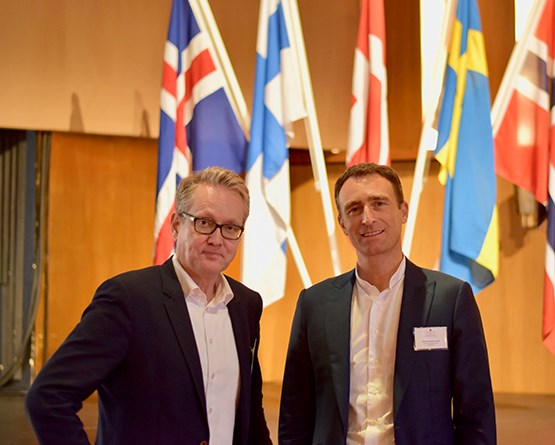 24.06.2019
24.06.2019
Hvordan håndterer man bedst forandringer?
Af Nikolaj Henum
Álvaro González Alorda er en af verdens førende talere når det gælder forandringsledelse og er associate professor ved Headspring Executive Development – i foråret 2019 var Alvaro González Alorda i København i forbindelse med en konference, der skulle være med til at ændre virksomheders mindset i bestræbelserne på at få flere kvinder i ledelsen.
Álvaro González Alorda formåede at få tilhørerne i salen til at lytte efter, og de budskaber, han kom ud over rampen med, var ganske nyttige.
Efterfølgende tog vi en snak med Álvaro González Alorda om forandringsledelse:
Nowadays, many organisations need to broach a transformation. Are they prepared to go through this process?
—Traditional management competencies are not sufficient when it comes to implementing extraordinary changes: like reinventing declining business models; or redesigning complex processes; or restoring good relations amongst members of a management team; or regaining the enthusiasm of a team that is suffering the effects of fatigue. To put it in a few words, nowadays, there is no lack of managers, management competencies are not a scarce resource. Nowadays, there’s lack of leaders with the capacity to transform.
What role does the methodology play in a transformation?
—The transformation efforts of organisations are frequently dissipated due to the lack of a defined methodology or the methodology employed is too complex. In the first case, the organisation places too much faith in the initial enthusiasm created by the change process; and in the second, the organisation is placed at the service of the methodology, when it should be the other way round. There is a tendency for large companies to apply complex solutions, when transformation really just requires a simple methodology.
So, is it enough just to have a good methodology?
—We cannot tackle a transformation process simply by following an instruction manual. Throughout the transformation process we must constantly gauge the situation within the organisation and at the same time, accompany the leaders and each member of the team effectively. Transformation is not an industrial process, but a question of handcrafted leadership. Person by person.
How can we achieve a transformation that is sustainable over time?
—Transformations tend to revolve around projects, which are a basic way of focusing the organisation’s efforts on strategic priorities. However, only half the success of a transformation process depends on the implementation of these projects. The other half consists of the new competencies that members of the team must acquire. In other words, in order to achieve a transformation that is sustainable, a series of new competencies must be developed among members of the team, while others need to be strengthened.
Can you give us an example of an essential transformation competency?
—One of the leadership competencies that is most critical when it comes to accelerating and boosting the impact of a transformation is giving feedback. But I’m not referring to procedures managed by Human Resources, such as performance evaluation or 360-degree exercises. I’m referring to a gift that anyone in a company can make to anyone else by making them aware of an improvement opportunity, irrespectively of hierarchy or operational area; this kind of feedback, rather than undermining them or stabbing them in the back, becomes a key accelerator of the transformation process.

Must transformation always imply a digital transformation?
—Many companies are finding, on a daily basis, that digital transformation is a strategic requirement to overcome disruption in their industry. However, digital transformation goes beyond merely technological questions, because it’s not simply a matter of digitalising analogue business models, but creating new business models through digital platforms. And in order to do so, it’s essential to transform as well the digital tools and the collaboration culture. A digital transformation is just a superficial change if you don’t transform the whole organization.
How can we handle day-to-day pressures while undertaking a transformation?
—Transformation hurts, just like going on a diet or following a demanding training program. But experience shows that people are willing to make an extraordinary effort when their leaders inspire them. However, some managers have a tendency to hold back the transformation process by exaggerating the effort that the team must make. And they adopt a paternalistic attitude that often hides their lack of involvement in the process and their lack of leadership.
So, who is an inspiring leader?
—Inspiring someone doesn’t mean putting on the occasional show by dazzling people with certain outstanding personal qualities. A leader inspires you when he or she helps you to change your habits by developing new competencies, thus transforming your life.
What role do the managers play in terms of leading a transformation?
—I think there are two kinds of managers: managers with a vision reduced to their own function, and managers who have a global vision of the company and leadership that inspires the whole organisation. Transformation processes can reveal the lack of leadership in the management team in the same way that naked swimmers are exposed at low tide.
How can we achieve a sense of commitment to a transformation process?
—There are three factors that drive a transformation process: first, the sense of achievement that is generated in those leading the transformation as they see the results; second, the sense of self-esteem arising from developing new competencies; and third, the recognition they receive from top management. Transformation is a delicate process that requires the ongoing drive and encouragement of the management team.
How can we maintain the pace of transformation over time?
—Transformation processes necessarily take time, because they need to have a significant impact on three dimensions: the business model, the organisation structure and the competencies of the team. And it’s easy to fall into two traps during this process: firstly, wanting to change everything in just a few months, thus provoking organisational collapse. And secondly, when the difficulties that arise during the process are used as an excuse to slacken the pace of change or to modify the transformation methodology itself. There are no short-cuts: transformation is a continuous process that requires a consistent methodology.
In order to transform the organisation, must we also transform people?
—Absolutely! A key transformation skill is closeness: being close to people and staying in close contact with reality. And to achieve this, we must break away from the idea of managing the team from behind a keyboard and a screen, shooting messages from a distance like a sniper. To the contrary: close contact with employees enables leaders to tackle the constant difficulties that arise during the transformation process, not simply in the form of general guidelines handed down from above, but through ongoing and inspiring conversations that bring all members of the team into line and imbue each individual with renewed enthusiasm. An authentic business transformation is always based on a series of personal transformative experiences. And there is no more effective transformative tool than a face-to-face conversation.
How can we measure transformation?
—A clear indicator to measure the degree of transformation of a company is the speed with which the organization translates strategic priorities into specific projects, achieves quick-wins and then each team delivers with a defiant smile that says ‘Next?’.
At valget faldt på at det skulle være Alvaro Gonzàlez Alorda, som skulle holde et indlæg til konferencen, var ikke en tilfældighed.
”Vi samarbejder i dag med Above and Beyond, der står bag konferencen Womenomic, og det gør vi, fordi vi finder det utrolig vigtigt, at få flere i kvinder i ledelsen. Vores Diversity Council har rødder i Danmark, men den har nu også bredt sig internationalt,” siger Henrik Waitz, VP i Headspring Executive, og tilføjer:
”Jeg har selv arbejdet med problemstillingen i Danmark igennem flere år, og da jeg blev tilknyttet Headspring Executive Development, som udspringer af et samarbejde mellem IE Business School i Madrid og Financial Times, blev de meget interesserede og ville meget gerne engagere sig i denne mission,” fortæller han.
”Vi har mulighed for at trække på nogle verdens førende inden for forandringsledelse, eksempelvis Álvaro González Alorda, der også er meget flittig brugt og blandt andet gæster de såkaldte Ted Talks,” siger Henrik Waitz.